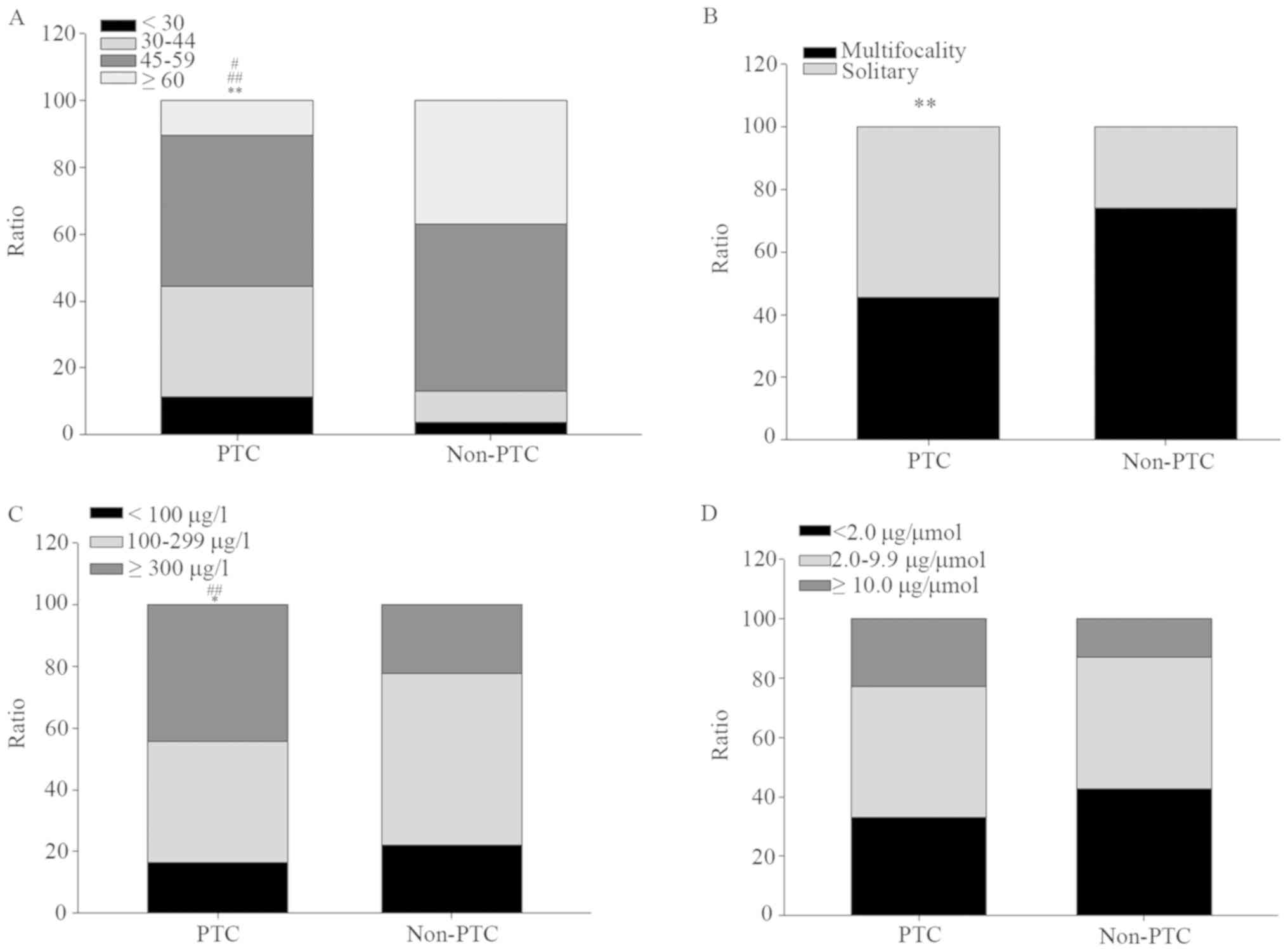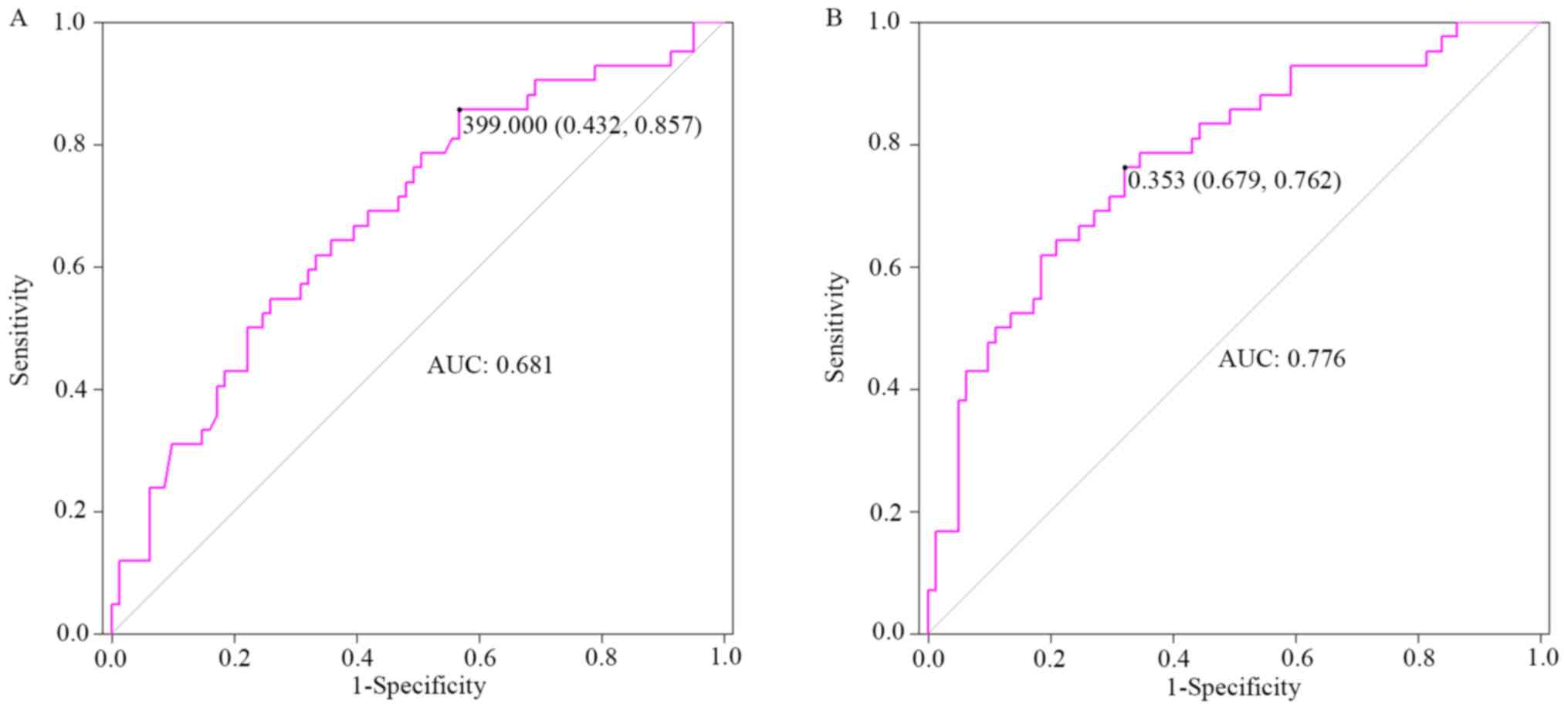|
1
|
Sui C, Liang N, Du R, He Q, Zhang D, Li F,
Fu Y, Dionigi G and Sun H: Time trend analysis of thyroid cancer
surgery in China: Single institutional database analysis of 15,000
patients. Endocrine. 68:617–628. 2020. View Article : Google Scholar : PubMed/NCBI
|
|
2
|
Brito JP, Gionfriddo MR, Al Nofal A,
Boehmer KR, Leppin AL, Reading C, Callstrom M, Elraiyah TA, Prokop
LJ, Stan MN, et al: The accuracy of thyroid nodule ultrasound to
predict thyroid cancer: Systematic review and meta-analysis. J Clin
Endocrinol Metab. 99:1253–1263. 2014. View Article : Google Scholar : PubMed/NCBI
|
|
3
|
Kitahara CM and Sosa JA: The changing
incidence of thyroid cancer. Nat Rev Endocrinol. 12:646–653. 2016.
View Article : Google Scholar : PubMed/NCBI
|
|
4
|
Lee JH, Song RY, Yi JW, Yu HW, Kwon H, Kim
SJ, Chai YJ, Choi JY, Moon JH, Lee KE, et al: Case-control study of
papillary thyroid carcinoma on urinary and dietary iodine status in
South Korea. World J Surg. 42:1424–1431. 2018. View Article : Google Scholar : PubMed/NCBI
|
|
5
|
Zhou Z, Zhang J, Jiang F, Xie Y, Zhang X
and Jiang L: Higher urinary bisphenol a concentration and excessive
iodine intake are associated with nodular goiter and papillary
thyroid carcinoma. Biosci Rep. 37:BSR201706782017. View Article : Google Scholar : PubMed/NCBI
|
|
6
|
Zhang L, Fang C, Liu L, Liu X, Fan S, Li
J, Zhao Y, Ni S, Liu S and Wu Y: A case-control study of urinary
levels of iodine, perchlorate and thiocyanate and risk of papillary
thyroid cancer. Environ Int. 120:388–393. 2018. View Article : Google Scholar : PubMed/NCBI
|
|
7
|
Zhao H, Li H and Huang T: High urinary
iodine, thyroid autoantibodies, and thyroid-stimulating hormone for
papillary thyroid cancer risk. Biol Trace Elem Res. 184:317–324.
2018. View Article : Google Scholar : PubMed/NCBI
|
|
8
|
Zhao H, Li H and Huang T: High iodine
intake and central lymph node metastasis risk of papillary thyroid
cancer. J Trace Elem Med Biol. 53:16–21. 2019. View Article : Google Scholar : PubMed/NCBI
|
|
9
|
Wang F, Wang Y, Wang L, Wang X, Sun C,
Xing M and Zhao W: Strong association of high urinary iodine with
thyroid nodule and papillary thyroid cancer. Tumour Biol.
35:11375–11379. 2014. View Article : Google Scholar : PubMed/NCBI
|
|
10
|
Kim HJ, Park HK, Byun DW, Suh K, Yoo MH,
Min YK, Kim SW and Chung JH: Iodine intake as a risk factor for
BRAF mutations in papillary thyroid cancer patients from an
iodine-replete area. Eur J Nutr. 57:809–815. 2018. View Article : Google Scholar : PubMed/NCBI
|
|
11
|
Vuong HG, Kondo T, Oishi N, Nakazawa T,
Mochizuki K, Inoue T, Tahara I, Kasai K, Hirokawa M, Tran TM and
Katoh R: Genetic alterations of differentiated thyroid carcinoma in
iodine-rich and iodine-deficient countries. Cancer Med.
5:1883–1889. 2016. View
Article : Google Scholar : PubMed/NCBI
|
|
12
|
Lv C, Yang Y, Jiang L, Gao L, Rong S,
Darko GM, Jiang W, Gao Y and Sun D: Association between chronic
exposure to different water iodine and thyroid cancer: A
retrospective study from 1995 to 2014. Sci Total Environ.
609:735–741. 2017. View Article : Google Scholar : PubMed/NCBI
|
|
13
|
Bogdanova TI, Saenko VA, Hirokawa M, Ito
M, Zurnadzhy LY, Hayashi T, Rogounovitch TI, Miyauchi A, Tronko MD
and Yamashita S: Comparative histopathological analysis of sporadic
pediatric papillary thyroid carcinoma from Japan and Ukraine.
Endocr J. 64:977–993. 2017. View Article : Google Scholar : PubMed/NCBI
|
|
14
|
Santos JE, Freitas M, Fonseca CP, Castilho
P, Carreira IM, Rombeau JL and Branco MC: Iodine deficiency a
persisting problem: Assessment of iodine nutrition and evaluation
of thyroid nodular pathology in Portugal. J Endocrinol Invest.
40:185–191. 2017. View Article : Google Scholar : PubMed/NCBI
|
|
15
|
Zhang YL, Li P, Liu ZY, Yi JP, Chen Y,
Zhang M and Lin Q: Does relatively low iodine intake contribute to
thyroid cancer? An ecological comparison of epidemiology. Medicine
(Baltimore). 98:e175392019. View Article : Google Scholar : PubMed/NCBI
|
|
16
|
World Health Organization, UNICEFICCIDD, .
Assessment of iodine deficiency disorders and monitoring their
elimination, a guide for programme managers Third edition (updated
1st September 2008). 32–33
|
|
17
|
Gao J, Zhang ZJ, Wang ZL, Bian JC, Wang
JB, Jiang W, Wang XM and Jiang QW: Spatial distribution
characteristics and influencing factors of iodine in drinking water
in Shandong Province between year 2008 and 2010. Zhonghua Yu Fang
Yi Xue Za Zhi. 47:18–22. 2013.(In Chinese). PubMed/NCBI
|
|
18
|
Horvath E, Majlis S, Rossi R, Franco C,
Niedmann JP, Castro A and Dominguez M: An ultrasonogram reporting
system for thyroid nodules stratifying cancer risk for clinical
management. J Clin Endocrinol Metab. 94:1748–1751. 2009. View Article : Google Scholar : PubMed/NCBI
|
|
19
|
Zimmermann MB and Boelaert K: Iodine
deficiency and thyroid disorders. Lancet Diabetes Endocrinol.
3:286–295. 2015. View Article : Google Scholar : PubMed/NCBI
|
|
20
|
Mitro SD, Rozek LS, Vatanasapt P,
Suwanrungruang K, Chitapanarux I, Srisukho S, Sriplung H and Meza
R: Iodine deficiency and thyroid cancer trends in three regions of
Thailand, 1990–2009. Cancer Epidemiol. 43:92–99. 2016. View Article : Google Scholar : PubMed/NCBI
|
|
21
|
Xiang J, Wang X, Wang Z, Wu Y, Li D, Shen
Q, Sun T, Guan Q and Wang Y: Effect of different iodine
concentrations on well-differentiated thyroid cancer cell behavior
and its inner mechanism. Cell Biochem Biophys. 71:299–305. 2015.
View Article : Google Scholar : PubMed/NCBI
|
|
22
|
Wang J, Yang H, Si Y, Hu D, Yu Y, Zhang Y,
Gao M and Zhang H: Iodine promotes tumorigenesis of thyroid cancer
by suppressing mir-422a and up-regulating MAPK1. Cell Physiol
Biochem. 43:1325–1336. 2017. View Article : Google Scholar : PubMed/NCBI
|
|
23
|
Xu C, Wu F, Mao C, Wang X, Zheng T, Bu L,
Mou X, Zhou Y, Yuan G, Wang S and Xiao Y: Excess iodine promotes
apoptosis of thyroid follicular epithelial cells by inducing
autophagy suppression and is associated with Hashimoto thyroiditis
disease. J Autoimmun. 75:50–57. 2016. View Article : Google Scholar : PubMed/NCBI
|
|
24
|
Huang F, Sun Y, Gao H, Wu H and Wang Z:
Carbon disulfide induces embryo loss by perturbing the expression
of the mTOR signalling pathway in uterine tissue in mice. Chem Biol
Interact. 300:8–17. 2019. View Article : Google Scholar : PubMed/NCBI
|
|
25
|
Zhao X, Hou P, Xin H, Zhang Y, Zhou A, Lai
C and Xie J: A glucogalactomanan polysaccharide isolated from
Agaricus bisporus causes an inflammatory response via the ERK/MAPK
and IKB/NFKB pathways in macrophages. Int J Biol Macromol.
151:1067–1073. 2020. View Article : Google Scholar : PubMed/NCBI
|
|
26
|
Geng J, Li X, Zhou Z, Wu CL, Dai M and Bai
X: EZH2 promotes tumor progression via regulating VEGF-A/AKT
signaling in non-small cell lung cancer. Cancer Lett. 359:275–287.
2015. View Article : Google Scholar : PubMed/NCBI
|
|
27
|
Tsai HC, Cheng SP, Han CK, Huang YL, Wang
SW, Lee JJ, Lai CT, Fong YC and Tang CH: Resistin enhances
angiogenesis in osteosarcoma via the MAPK signaling pathway. Aging
(Albany NY). 11:9767–9777. 2019. View Article : Google Scholar : PubMed/NCBI
|
|
28
|
Wheeler KC, Jena MK, Pradhan BS, Nayak N,
Das S, Hsu CD, Wheeler DS, Chen K and Nayak NR: VEGF may contribute
to macrophage recruitment and M2 polarization in the decidua. PLoS
One. 13:e01910402018. View Article : Google Scholar : PubMed/NCBI
|
|
29
|
Song J, Qiu W, Deng X, Qiu Z, Fan Y and
Yang Z: A somatic mutation of RasGRP3 decreases
Na+/I− symporter expression in metastases of
radioactive iodine-refractory thyroid cancer by stimulating the Akt
signaling pathway. Am J Cancer Res. 8:1847–1855. 2018.PubMed/NCBI
|
|
30
|
Subarnbhesaj A, Miyauchi M, Chanbora C,
Mikuriya A, Nguyen PT, Furusho H, Ayuningtyas NF, Fujita M,
Toratani S, Takechi M, et al: Roles of VEGF-Flt-1 signaling in
malignant behaviors of oral squamous cell carcinoma. PLoS One.
12:e01870922017. View Article : Google Scholar : PubMed/NCBI
|
|
31
|
Li Y, Sun R, Zou J, Ying Y and Luo Z: Dual
roles of the AMP-activated protein kinase pathway in angiogenesis.
Cells. 8:7522019. View Article : Google Scholar
|
|
32
|
Shakya G, Balasubramanian S, Hoda M and
Rajagopalan R: Inhibition of metastasis and angiogenesis in Hep-2
cells by wheatgrass extract-an in vitro and in silico approach.
Toxicol Mech Methods. 28:205–218. 2018. View Article : Google Scholar : PubMed/NCBI
|
|
33
|
Welsh SJ, Rizos H, Scolyer RA and Long GV:
Resistance to combination BRAF and MEK inhibition in metastatic
melanoma: Where to next? Eur J Cancer. 62:76–85. 2016. View Article : Google Scholar : PubMed/NCBI
|
|
34
|
Hegde PS, Wallin JJ and Mancao C:
Predictive markers of anti-VEGF and emerging role of angiogenesis
inhibitors as immunotherapeutics. Semin Cancer Biol. 52:117–124.
2018. View Article : Google Scholar : PubMed/NCBI
|
|
35
|
Turkowski K, Brandenburg S, Mueller A,
Kremenetskaia I, Bungert AD, Blank A, Felsenstein M and Vajkoczy P:
VEGF as a modulator of the innate immune response in glioblastoma.
Glia. 66:161–174. 2018. View Article : Google Scholar : PubMed/NCBI
|
















